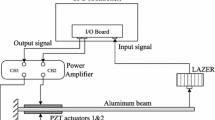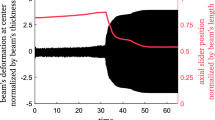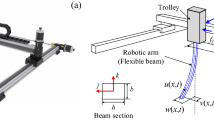Abstract
In this article, we propose an active/passive vibration controller for a cantilever beam using a sliding mass-spring-dashpot mechanism. The controller is placed at the free end of the beam, introducing Coriolis, inertia, and centripetal nonlinearities into the system, resulting in nonlinear coupling that may be used to quench the transient vibration of the beam. When the natural frequency of the slider is twice the fundamental beam frequency (2:1 internal resonance), the two systems will be coupled through nonlinearities that cause the oscillatory energy to be transferred back and forth between the beam and the slider. Control is achieved once the vibration of the beam is absorbed by the slider and dissipated through the slider damping. Numerical results show that this technique can improve the effective damping ratio of the structure by a factor of 15. This technique is particularly useful for reducing large-amplitude oscillations to levels that may be managed using conventional methods.
Due to the nonlinearities in the system, for small or zero controller damping, chaotic transient oscillations can occur depending on the amplitude of the initial disturbance of the beam.
Similar content being viewed by others
References
L. Meirovitch,Dynamics and Control of Structures. John Wiley and Sons Inc.: New York, 1990.
G.A. Foelsche, J.H. Giffin, and J. Bielak, “Transient response of joint dominated space structures: a new linearization technique,”AIAA J. vol. 26, no. 10, pp. 915–921, 1988.
P.M. Bainum, “A review of modelling techniques for the open and closed-loop dynamics of large space structures,” S.N. Atluri and A.K. Amos (eds.),Large Space Structures: Dynamics and Control, Springer Series in Computational Mechanics. Springer-Verlag: Berlin, Heidelberg, 1988.
“Modeling analysis and optimization issues for large space structures,” in D. Pinson, A.K. Amos, and V.B. Vankayya,NASA/AFOSR Workshop, Williamsburg, VA, pp. 1768–1774, May 1982.
A.H. Von Flotow and B. Schafer, “Wave-absorbing controllers for a flexible beam,”J. Guidance Control Dynamics, vol. 9, no. 6, pp. 673–680, 1986.
P.J. Lynch and S.S. Banda, “Active control for vibration damping,” in S.N. Atluri and A.K. Amos (eds.),Large Space Structures: Dynamics and Control, Springer Series in Computational Mechanics. Springer-Verlag: Berlin, Heidelberg, 1988.
A.A. Ferri, “Damping and vibration of beams with various types of frictional support conditions,”Proc. AIAA/ASME/ASCE/AHS/ASC 30th Structures, Structural Dynamics and Materials Conf., Mobile, AL, April 30, 1989.
A.Y. Chen and F.C. Moon, “Experimental vibration suppression in a space truss using self-equilibrated collocated feedback control,” submitted.
A.H. Nayfeh and D.T. Mock,Nonlinear Oscillations. John Wiley and Sons: New York, 1979.
M.F. Golnaraghi, F.C. Moon, and R.H. Rand, “Resonance in a high-speed flexible-arm robot,”Int. J. Dynamics and Stability Syst., vol. 4, nos. 3 & 4, pp. 169–188, 1989.
M.F. Golnaraghi, “Vibration suppression of flexible structures using internal resonance,”Mech. Res. Commun., vol. 18, no. 2/3, pp. 135–143, 1991.
T. Singh, M.F. Golnaraghi, and R.N. Dubey, “Effects of joint flexibility on the motion of a flexible-arm robot,”Int. J. Dynamics Stability Systems, vol. 6, no. 6, In press page # unknown, 1991.
A.H. Nayfeh,Introduction to Perturbation Techniques. John Wiley and sons: New York, 1981.
R.H. Rand and D. Armbruster,Perturbation Methods, Bifurcation Theory and Computer Algebra Perturbation Methods, Applied Mathematical Sciences, vol. 65. Springer-Verlag: New York, 1987.
R. H. Rank,Computer Algebra in Applied Mathematics: An Introduction to MACSYMA, Research Notes in Mathematics, vol. 94. Pitman: Boston, 1984.
J. Kevorkian and J.D. Cole,Perturbation Methods in Applied Mathematics. Springer-Verlag: New York, 1981.
Author information
Authors and Affiliations
Additional information
Editor: T. Vincent
Rights and permissions
About this article
Cite this article
Golnaraghi, M.F. Regulation of flexible structures via nonlinear coupling. Dynamics and Control 1, 405–428 (1991). https://doi.org/10.1007/BF02169768
Received:
Revised:
Issue Date:
DOI: https://doi.org/10.1007/BF02169768




